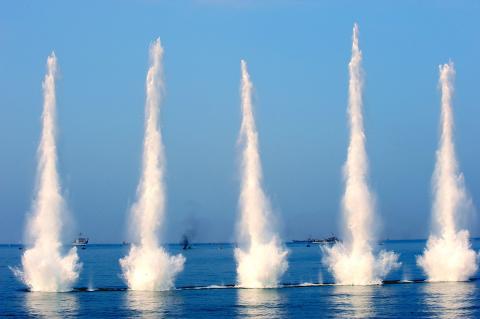The military held war games to drill its paratrooper and airborne defense units at an airbase in Greater Taichung yesterday as part of this year’s five-day Han Kuang series of exercises.
The 50-minute drill, which started at 7:30am at the Ching Chuan Kang Airbase, resembled a scrimmage, albeit with heavy weaponry and military expertise.
Planners divided a total of 2,596 soldiers into two teams of attackers and defenders.

Photo: Liao Yao-tung, Taipei Times
The attack group launched two Indigenous Defense Fighter aircraft to clear the ground. Then, an onslaught of paratroopers, including 206 elite airborne soldiers, jumped out of transport aircraft to take the territory.
At the same time, ground defenders used the weapons at their disposal to repel the invaders. They deployed AH-1W Super Cobra attack helicopters, OH-58D scout and attack helicopters, and physical barriers to block the advances by the paratroopers. In addition, the defenders also released smoke to disorient the airborne troops during their landing.
This drill marked the first Han Kuang exercise in which female soldiers — eight in all — took part in a simulated parachute offensive, the Ministry of National Defense said.

Photo: Chang Chung-yi, Taipei Times
The drill came two days after the military staged another simulation to practice emergency landings and takeoffs on a section of freeway in Greater Tainan, which acts as a runway of last resort if airbases have already been taken out by enemy bombers.
Meanwhile, in other Han Kuang-related action, more than 3,000 troops engaged in an amphibious landing drill in Pingtung County.
At 7am, a fleet of amphibious gunboats approached the coast of Pingtung County and waited for marine specialists to launch bombs that would clear any mines from the waters. Their cargo included marines, M60A3 tanks and other armored vehicles.
When the coast was clear, troops started assaulting the beachhead from their amphibious transports and assault vehicles. At the same time, jet fighters and attack helicopters were also deployed to facilitate the landing operation.
During the offensive, one jeep was seen stuck on the beach and was later rescued by an armored vehicle, a scene that many spectators had thought was a mishap.
When the jeep was pulled onshore, however, the military broadcast said the beach “rescue” operation was “conducted successfully.”
The disabled jeep was reportedly part of the drill.
Chang Shou-ling (張壽齡), a senior official in the Marine Corps, said the rescue challenge was included to simulate a common glitch in these operations — that any landing vehicle could get stuck owing to conditions on the ground.
This year’s Han Kuang military exercises began on Monday and end today.

The US government has signed defense cooperation agreements with Japan and the Philippines to boost the deterrence capabilities of countries in the first island chain, a report by the National Security Bureau (NSB) showed. The main countries on the first island chain include the two nations and Taiwan. The bureau is to present the report at a meeting of the legislature’s Foreign Affairs and National Defense Committee tomorrow. The US military has deployed Typhon missile systems to Japan’s Yamaguchi Prefecture and Zambales province in the Philippines during their joint military exercises. It has also installed NMESIS anti-ship systems in Japan’s Okinawa

‘WIN-WIN’: The Philippines, and central and eastern European countries are important potential drone cooperation partners, Minister of Foreign Affairs Lin Chia-lung said Minister of Foreign Affairs Lin Chia-lung (林佳龍) in an interview published yesterday confirmed that there are joint ventures between Taiwan and Poland in the drone industry. Lin made the remark in an exclusive interview with the Chinese-language Liberty Times (the Taipei Times’ sister paper). The government-backed Taiwan Excellence Drone International Business Opportunities Alliance and the Polish Chamber of Unmanned Systems on Wednesday last week signed a memorandum of understanding in Poland to develop a “non-China” supply chain for drones and work together on key technologies. Asked if Taiwan prioritized Poland among central and eastern European countries in drone collaboration, Lin

NO CONFIDENCE MOTION? The premier said that being toppled by the legislature for defending the Constitution would be a democratic badge of honor for him Premier Cho Jung-tai (卓榮泰) yesterday announced that the Cabinet would not countersign the amendments to the local revenue-sharing law passed by the Legislative Yuan last month. Cho said the decision not to countersign the amendments to the Act Governing the Allocation of Government Revenues and Expenditures (財政收支劃分法) was made in accordance with the Constitution. “The decision aims to safeguard our Constitution,” he said. The Constitution stipulates the president shall, in accordance with law, promulgate laws and issue mandates with the countersignature of the head of the Executive Yuan, or with the countersignatures of both the head of the Executive Yuan and ministers or

CABINET APPROVAL: People seeking assisted reproduction must be assessed to determine whether they would be adequate parents, the planned changes say Proposed amendments to the Assisted Reproduction Act (人工生殖法) advanced yesterday by the Executive Yuan would grant married lesbian couples and single women access to legal assisted reproductive services. The proposed revisions are “based on the fundamental principle of respecting women’s reproductive autonomy,” Cabinet spokesperson Michelle Lee (李慧芝) quoted Vice Premier Cheng Li-chiun (鄭麗君), who presided over a Cabinet meeting earlier yesterday, as saying at the briefing. The draft amendment would be submitted to the legislature for review. The Ministry of Health and Welfare, which proposed the amendments, said that experts on children’s rights, gender equality, law and medicine attended cross-disciplinary meetings, adding that